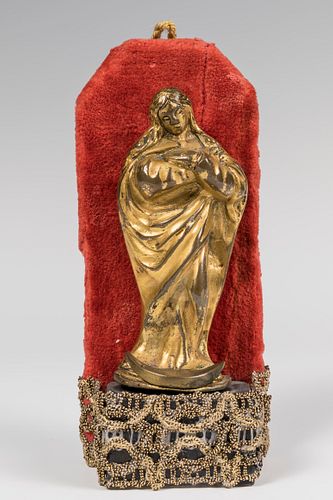Andalusian School; XVII century. "Purisima". Gilded bronze.
Lot 13
About Seller
Setdart Auction House
Carrer Aragó 346
Barcelona
Spain
Setdart Subastas was born in 2004 and is currently the first online art auction in Spain with solidity, prestige and reliability guaranteed by our more than 60,000 users. Setdart has a young, dynamic and enterprising team ready to successfully manage the purchase and sale of art works through custom...Read more
Estimate:
EUR€3,500 - EUR€4,000
$3,763.44 - $4,301.08
Absentee vs Live bid
Two ways to bid:
- Leave a max absentee bid and the platform will bid on your behalf up to your maximum bid during the live auction.
- Bid live during the auction and your bids will be submitted real-time to the auctioneer.
Bid Increments
| Price | Bid Increment |
|---|---|
| EUR€0 | EUR€10 |
| EUR€200 | EUR€25 |
| EUR€500 | EUR€50 |
| EUR€1,000 | EUR€100 |
| EUR€3,000 | EUR€200 |
| EUR€5,000 | EUR€500 |
| EUR€10,000 | EUR€1,000 |
| EUR€20,000 | EUR€2,000 |
| EUR€50,000 | EUR€5,000 |
About Auction
By Setdart Auction House
Oct 20, 2021
Set Reminder
2021-10-20 07:30:00
2021-10-20 07:30:00
America/New_York
Bidsquare
Bidsquare : OLD MASTERS
https://www.bidsquare.com/auctions/setdart-auction-house/old-masters-7700
Setdart Auction House sofia@setdart.com
Setdart Auction House sofia@setdart.com
- Lot Description
Andalusian School; XVII century. "Purisima". Gilded bronze. Present damages. Measures: 7.5 x 3 x 2 cm; 11.5 x 5 x 4 cm (support). The definitive icnographic image of the Purisima took shape in the 16th century, and apparently in Spain. Following a Valencian tradition, the Jesuit Father Alberro had a vision and described it to the painter Juan de Juanes so that he could capture it as faithfully as possible. It is an evolved iconographic concept, sometimes associated with the theme of the Coronation of the Virgin. Mary appears standing, dressed in a white tunic and blue mantle, her hands crossed on her chest, with the moon at her feet and stepping on the infernal serpent, symbol of her victory over Original Sin. The artists of the 17th century faithfully maintained the iconographic type, but dispensed with the symbols of the litanies or reduced them, incorporating them into the composition in a naturalistic way, and sought a greater dynamism and sense of theatricality. This tendency will culminate in the 18th century, when we find compositions like the one we present here, with Mary surrounded by angels, still with some iconographic attributes but already very reduced. Given the importance given to religious images in the Hispanic world, during the 17th and 18th centuries ambitious pictorial series and extensive iconographic programs were created for churches and convents, as well as printed prints, medals and reliquaries for private devotion. As a whole, regardless of their size or support, these images fulfilled the objective of sacralizing daily life beyond the altars. The Granada school stood out during this period, receiving and developing the stylistic patterns of the Baroque. It is evident the leading role played by the Andalusian school of sculpture during the period that has been called the Golden Age; to it belong a series of masters of unquestionable value who knew how to combine in their works the extraordinary technical quality and religious depth, in accordance with the atmosphere of their time, fully connected with the tastes of the clientele, more interested in the work of religious themes than in the commissions of profane character, thus marking a substantial difference with respect to the production of other European countries. It is also worth mentioning that the economic development and the strength that Seville experienced after the Discovery of America, having become the gateway and port of the Indies, was quickly reflected in art; from the first decades of the century, masters of different origins began to visit the city constantly in search of the American market and the potential Sevillian clientele, increasingly attracted by the new artistic forms arriving from Italy.
- Shipping Info
-
In-house shipping available. Please inquire at admin@setdart.com.
-
- Buyer's Premium



 EUR
EUR CAD
CAD AUD
AUD GBP
GBP MXN
MXN HKD
HKD CNY
CNY MYR
MYR SEK
SEK SGD
SGD CHF
CHF THB
THB







